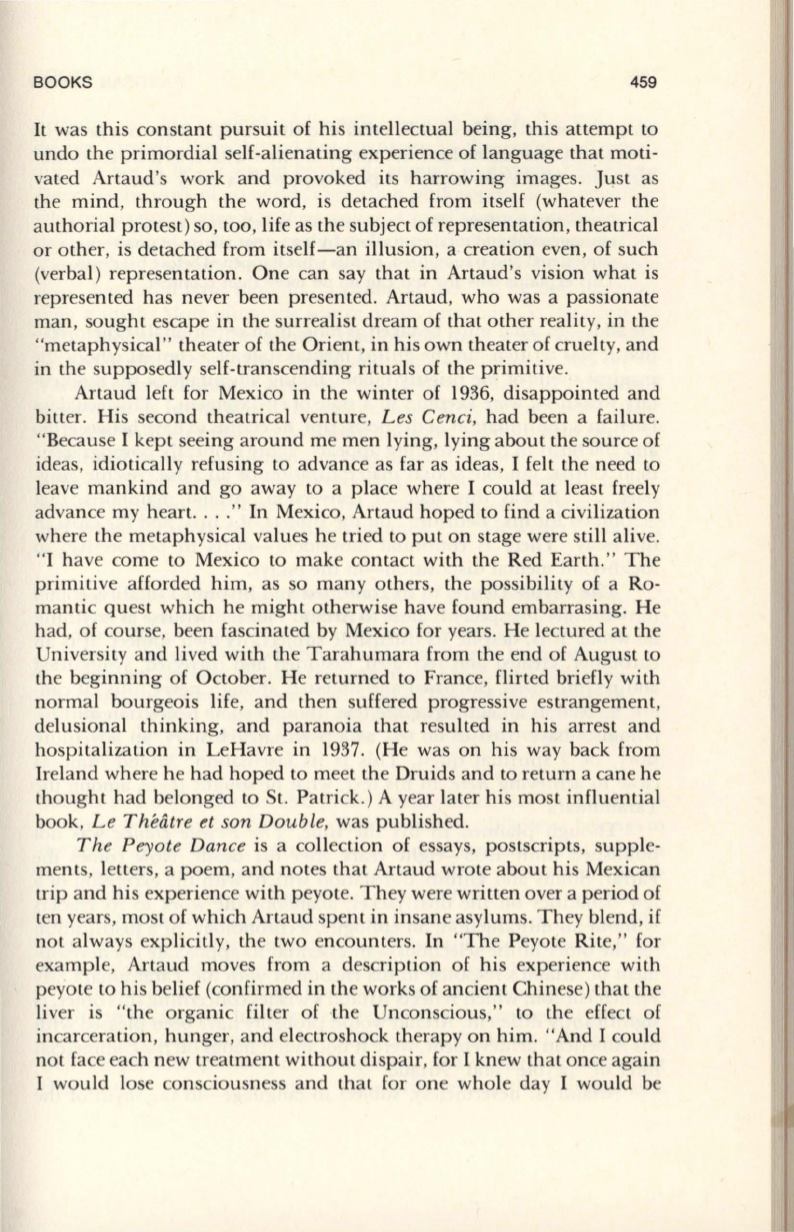
BOOKS
459
It
was this constant pursuit of his intellectual being, this attempt to
undo the primordial self-alienating experience of language that moti–
vated Artaud's work and provoked its harrowing images. Jl!st as
the mind, through the word, is detached from itself (whatever the
authorial protest) so, too, life as the subject of representation, theatrical
or other, is detached from itself-an illusion, a creation even, of such
(verbal) representation. One can say that in Artaud's vision what is
represented has never been presented. Artaud, who was a passionate
man, sought escape in the surrealist dream of that other reality, in the
"metaphysical " theater of the Orient, in his own theater of cruelty, and
in the supposedly self-transcending rituals of the primitive.
Artaud left for Mexico in the winter of 1936, disappointed and
bitler. His second theatrical venture,
Les Cenci,
had been a failure.
"Because I kept seeing around me men lying, lying about the source of
ideas, idiotically refusing to advance as far as ideas, I felt the need to
leave mankind and go away to a place where I could at least freely
advance my heart...."
In
Mexico, Artaud hoped to find a civilization
where the metaphysical values he tried to put on stage were still alive.
"I have come
to
Mexico to make contact with the Red Earth." The
primitive afforded him, as so many others, the possibility of a Ro–
mantic quest which he might otherwise have found embarrasing. He
had, of course, been fascinated by Mexico for years. He lectured at the
University and lived with the Tarahumara from the end of August to
the beginning of October. He returned
to
France, flirted briefly with
normal bourgeois life, and then suffered progressive estrangement,
delusional thinking, and paranoia that resulted in his arrest and
hospitalization in LeHavre in 1937. (He was on his way back from
Ireland where he had hoped to meet the Druids and to return a cane he
thought had belonged to St. Patrick.) A year later his most influential
book,
Le Theatre et son Double,
was published.
The Peyote Dance
is a collection of essays, postscripts, supple–
ments, letters, a poem, and notes that Artaud wrote about his Mexican
trip and his experience with peyote. They were written over a period of
ten years, most of which Artaud spent in insane asylums. They blend, if
not always explicitly, the two encounters.
In
"The Peyote Rite, " for
example, Artaud moves from a description of his experience with
peyote to his belief (confirmed in the works of ancient Chinese) that the
liver is "the organic filter of -the Unconscious," to the effect of
incarceration , hunger, and electroshock therapy on him. "And I could
not face each new treatment without dispair, for I knew that once again
I would lose consciousness and that for one whole day I would be


